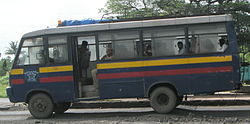Nagpur Police
This article may require copy editing for grammar, style, cohesion, tone, or spelling. (June 2017) |
| Nagpur Police | |
|---|---|
| Motto | Template:Lang-sa "Sadrakshṇāya Khālanīghrahaṇāya" (Template:Lang-en) |
| Agency overview | |
| Formed | 1861 |
| Jurisdictional structure | |
| Legal jurisdiction | Nagpur |
| Operational structure | |
| Agency executive |
|
| Facilities | |
| Stations | 28 |
| Lockups | 1 |
| Website | |
| Official website | |
Nagpur police is the law enforcement and investigation division of the Indian Police Service with jurisdiction over Nagpur district and Nagpur city in Maharashtra. Nagpur police has five zones and operates from 28 police stations spread across the city. It also has the responsibility of traffic policing the city roads.
It is widely believed that the Nagpur police was established during the 1861 police re-organization, but the city's policing history goes back far before that.
History
Nagpur was ruled by Gond kings and later by Maratha Bhonsale before the British East India Company took over the city. The Gond Kingdom and Bhonsale Raj had five elements based on ancient Indian and medieval police tradition, viz. police under revenue authorities, village kotwals and city kotwals. Kotwal was the cornerstone of Police establishment. There used to be a large establishment of Harkaras scattered over the Nagpur Province. Along with See bandies a small army at important places. The duty of Harkaras was to contact Kamavisdars and Patels to prevent crime and apprehend offenders.
When Raghoji III ascended the throne of the Nagpur kingdom in 1826, he allowed the Nagpur police to work independently under Salauddin. The law and order situation had improved under Raghuji's rule. He died without a male heir in 1853, and the kingdom was annexed by the British under the Doctrine of Lapse. In 1854, the Nagpur Police had five hundred men with a Daroga in each Tahsil and Naib Daroga and Jamadars posted in small Thanas and the Burkandaz (Sepoys) distributed as per requirements. Revenue department was merged into Nagpur police. Nagpur police was later on re-organized after new Central Provinces were formed along with Berar. City police had to face Nagpur Grain Riots of 1896-1897.
Organization

Currently Nagpur police top level includes 1 commissioner of police (Additional Director General of police Ranked) 1 Joint CP (Special Inspector General ranked) 4 Addl.CP (DIG Rank) 1 -ADMIN, 1-CRIME, 1-North Region, 1-South Region 8 Deputy Commissioners of Police - one for each zone(5 zones), 1 for D.C.P. Economic Cell & Cyber crime, 1 for special cases and 1 for traffic department. Criminal Investigation Department,1 for admin Nagpur is also a part of Nagpur police. Lower level officers include constables, Head constables, Asst.PSI, Police Sub-Inspector (PSI)Police inspectors(PI), Sr. Police inspectors(SPI), (DCP), deputy Supretendant of Police)/Asst. Commissioner(ACP)Superintendent of Police(SP)/Dpt. Commissioner(DSP).[1]
1994 Gowari stampede
On 23 November 1994, 114 people from the Gowari community were killed and 500 more injured in a stampede.[2] Nagpur Police were trying to disperse almost 50,000 Gowari protesters used a baton charge, but it created a panic and triggered a stampede amongst protesters.[3] Most of the casualties were women and children who were crushed to death as the crowd was scrambling to escape the police line. Some were victims of sharp barb piercing as they were climbing over a high fence to escape. Maharashtra state government appointed one man Justice S S Dani commission, to investigate the event,[2] but it held nobody responsible and referred to the tragedy as an "unfortunate" one. The commission upheld the police action of the baton charge on the surging crowd in order to maintain law and order while the assembly session was going on. It also noted that almost all deaths were caused due to breathless people getting crushed under the feet of running people and not due to injuries caused by the police baton charge. However, the commission suggested that water sprayers and rubber bullets be used first and a baton charge should be a last resort only after giving two warnings.
Samuels case
The Nagpur police claimed that they had tapes showing West Indies cricketer Marlon Samuels passing on information to a bookie just prior to the one day international game against India in Nagpur on 21 January 2007.[4] Virendra Thakur, Narendra Saoji, Birjesh Gwalvanshi are involved in double murder case under section 302 of IPC. Nagpur High Court rejected the bail application. The case was under investigation.
References
- ^ Nagpur Police
- ^ a b "State Orders Probe After Stampede Kills 114". www.highbeam.com. Retrieved 1994-11-25.
{{cite web}}: Check date values in:|accessdate=(help) - ^ "Dani exonerates Pawar; Govt rejects report". Retrieved 1998-12-31.
{{cite web}}: Check date values in:|accessdate=(help) - ^ Marlon Samuels in bookie row
